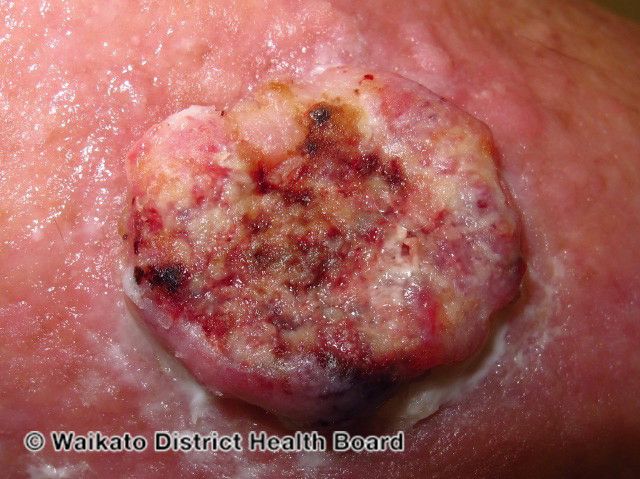- Acne
- Actinic Keratosis
- Aesthetics
- Alopecia
- Atopic Dermatitis
- Buy-and-Bill
- COVID-19
- Case-Based Roundtable
- Chronic Hand Eczema
- Chronic Spontaneous Urticaria
- Drug Watch
- Eczema
- General Dermatology
- Hidradenitis Suppurativa
- Melasma
- NP and PA
- Pediatric Dermatology
- Pigmentary Disorders
- Practice Management
- Precision Medicine and Biologics
- Prurigo Nodularis
- Psoriasis
- Psoriatic Arthritis
- Rare Disease
- Rosacea
- Skin Cancer
- Vitiligo
- Wound Care
News
Article
40-GEP Identifies Patients Who Benefit Most From Adjuvant Radiation Therapy With Improved Metastasis-Free Survival of cSCC
Author(s):
The goal of Arron et al’s study was to determine if the 40-GEP test could identify high-risk cSCC patients who would benefit from ART in controlling metastatic disease progression.
High-risk cutaneous squamous cell carcinoma
Image courtesy of the Waikato District Health Board and DermNetZ

According to a poster presentation from the 2023 Fall Clinical Dermatology Conference, the 40-gene expression profile (40-GEP) test identified patients who benefited the most from adjuvant radiation therapy (ART) with improved metastasis-free survival and delay or abrogation of nodal or distant metastasis of cutaneous squamous cell carcinoma (cSCC).
The goal of Arron et al’s study was to determine if the biology 40-GEP test could identify high-risk cSCC patients who would benefit from ART in controlling metastatic disease progression compared to patients who would not benefit.
In their study considerations, the authors wrote, “Criteria for recommendation of adjuvant radiation therapy (ART) for cSCC is based on a wide range of high-risk clinicopathologic features that have not been consistently demonstrated to predict benefit from ART. This has led to a broad scope of patients receiving treatment, with only a subset appearing to benefit. The 40-GEP classifies patients with a primary cSCC who have one or more clinicopathologic risk factors into low (class 1), moderate (class 2A), and high (class 2B) risk of regional, nodal, or distant metastasis. According to the authors, other validation studies have suggested that the 40-GEP test contributes “additive prognostic value to current risk assessment methods,” and can overall improve treatment decisions or high-risk cSCC.
For Arron et al’s study, initial eligible patients included 2 combined validation cohorts for the 40-GEP test where patients were confirmed eligible for testing and had a successful 40-GEP result (n=954). After excluding ineligible patients, 920 patients were matched on clinical risk factors stratified by ART. “Random sampling (x10,000) of ART status pairs and bootstrapping were used to avoid dropping any qualified patients and allow results to be generalizable to the cSCC high-risk population,” the authors wrote. Finally, each sample and resampled cohort was reviewed using survival methods and stratified by GEP and ART results.
The author’s first matched cohort analysis demonstrated benefit (50% increase) from ART for patients with a class 2b cSCC for 5-year metastasis-free survival. The authors also determined that class 2b results were the only factor in their study that identified patients that will benefit from ART, compared to clinicopathologic risk factors or risk assessment systems. Additionally, the authors found that class 2b patients who received ART showed a significant reduction in the cumulative probability of metastasis. Lastly, within cohort difference in predicted metastasis progression, 88% of class 2b patients benefited from ART.
From their findings, the authors concluded that the 40-GEP is ideal for identifying patients who will benefit from ART with improved metastasis-free survival and delay of nodal or distant metastasis, patients who are less likely to benefit from ART in controlling metastatic disease progression, and patients who will benefit from ART as a reduction in metastatic disease progression.
Reference
Arron S, Cañueto J, Siegel J, et al. Association of a 40-gene expression profile (40-GEP) with risk of metastatic disease progression of cutaneous squamous cell carcinoma (cSCC) and benefit of adjuvant radiation therapy (ART). Presented at: 2023 Fall Clinical Dermatology Conference; October 19-22, 2023; Las Vegas, NV.
Newsletter
Like what you’re reading? Subscribe to Dermatology Times for weekly updates on therapies, innovations, and real-world practice tips.















